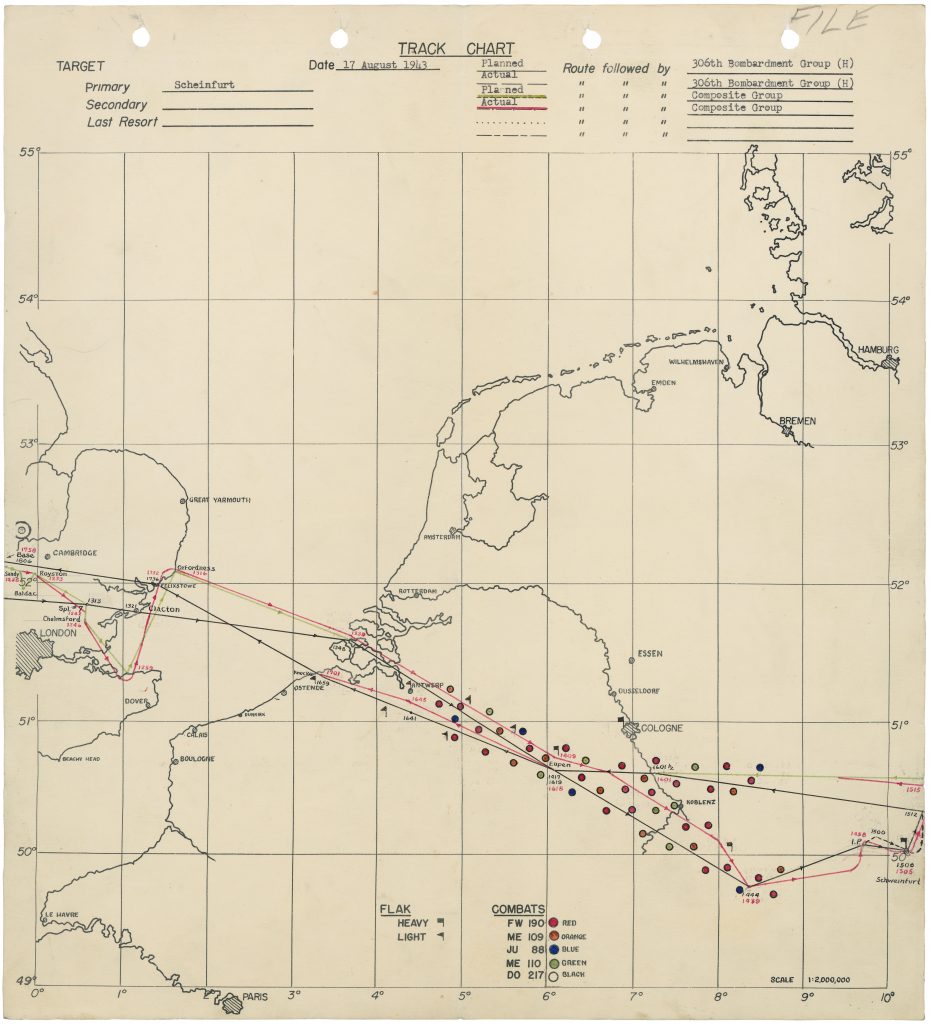B-17 Bomber Flying Fortress – The Queen Of The Skies Schweinfurt Raid – 17/08/1943
 English
English Deutsch
Deutsch
Schweinfurt became a fateful word for the 8th Air Force when it suffered heavy losses here in August 1943.
Werbung/Advertisement“I learned firsthand that a person can come to terms with the fact of their own death without panicking.”
Unknown American airman who survived the attack on Schweinfurt on August 17th, 1943
It was August 17, 1943, and it was exactly one year ago that the 8th US Air Force began bombing Fortress Europe from its bases in Great Britain.
The skies over the American bases in East England were overcast, and the crews of the Flying Fortress waited eagerly to see if they would actually go into action or not – some of them for up to six hours. The excitement was heightened by the importance of this operation to everyone, from generals to men of simple rank: it was the first, purely strategic bombing mission to strike at the lifelines of German industry, thus shortening the cruel war.
“Okay, people,” the preliminary briefing said, “We’re going to attack the ball bearing factories in the town called Schweinfurt in Bavaria. In the process, we will be forced to fly right through the middle of Germany, both in and out. Half of all German ball bearings are produced in the factories there, and if we destroy them, our attack will be a success.
We will fly at an altitude of 23,000 feet (about 7,000 m) and try to split the forces of the enemy. The 3rd Division will take off first, attack Regensburg (the second largest aircraft factory in the German Reich) and then fly on to North Africa. The other two divisions will attack Schweinfurt and then return to England. Let’s hope it works out, because if we can’t fool them, probably three or four hundred planes…”
Prophetic words. The plan did not work, the German air defense discovered them too early, and as a result more than five hundred young Americans had to lose their lives.
The plan
The entire plan depended on perfect timing. 146 Flying Fortresses, together with almost 200 fighters that would provide support during the first hours, were to leave the English coast at Lowestoft, zigzag across the North Sea to Holland, turn south to Belgium and fly over Germany in a south-easterly direction until Mannheim, then turn east and bomb the Messerschmitt factory in Regensburg. The factory would have been a valuable target in itself, but it was only intended to serve as a decoy to divert the German interceptors. Ten minutes after the lead unit had taken off under the command of Curtis LeMay, it was followed by another 230 B-17s under the command of Brigadier General Robert Williams and a number of fighters on their way to the ball bearing factories in Schweinfurt.

And to make the confusion perfect, a mixed formation of medium bombers of the Typhoon and Mitchell type should cross the Strait of Dover and divert as many German interceptors as possible south, towards Brittany.
The start of the operation was scheduled for 8.30 am. At that time the fog still lay like a thick dripping blanket over East England.
LeMay’s squadrons at their base on the coast near Norfolk were the first to see a clearing up. Shortly after 9.00 o’clock the end of the runway became gradually visible, although the cloud base was still at zero feet.
The take-off
At 9.30am all the machines were in the air and formed a wide circle that stretched from Norwich to over The Wash. Now the remaining units of the 8th Air Force should join them. If they were more than ten minutes apart, the whole mission would be in vain. A larger time interval would make the confusion tactic a warning for the entire German air defense stations. With every minute that passed – and many more to come – the plan became more and more shaky.
Looking back, it is easy to say that it would have been better to abort the operation at this point and postpone it to another day. But who can say what was going on in the mind of Brigadier General Frederick L. Anderson when he was sitting in his command bunker in High Wycome as the sole responsible person and did not know what to do?
There was pressure from all sides to put the German strategic industry into a knockout blow. Pressure came from the US Air Force to prove that the strategy of mass attack was the right one. In addition, the meteorologists had predicted clear visibility for Central Europe, but were already expecting another bad weather phase lasting at least two weeks in the next few days.
For a whole hour the bomber forces assigned to Regensburg flew their holding pattern, and every movement of every aircraft was closely monitored on the radar screen by the German radio operators. Interceptors rose from the airfields in Holland and northern Germany, and they too began an aimless, lonely shadow dance, like a boxer in his corner, before the gong sounded for the next round. The Typhoons and Mitchells started their pointless provocation manoeuvres over the street of Dover. And General Anderson was still hesitant. At 10:00 a.m., the decision was forcibly taken away from him. If the Regensburg unit was to reach the unknown field airfields in Africa still with sufficient daylight, it had to fly off now.
The telexes in the control towers in East England started ticking and the 3rd Division of the US 8th Air Force took off towards the east.
The fog began to clear further south and inland, where the squadrons ordered to Schweinfurt were waiting for take-off. Further delays occurred while one squadron after the other entered the waiting loop. At about 13.15 the swarm of aircraft turned south, over the coast of Suffolk, across the North Sea and beyond the limits of all reason, into another world. Most of the second attack wave did not even see the tip of a protecting hunter after the Dutch coast had been overflown. Spitfires of the Royal Air Force welcomed them, but the long range – Thunderbolts had started 9 minutes too late and did not catch up with them.
Werbung/AdvertisementIn trouble
Rumor has it that General Anderson believed that if a ten-minute delay was enough to cause confusion in the ranks of the Air Force, a three-hour delay would do just as well. To underestimate the ability of the German radar warning system in this way was downright criminal. While a 10-minute gap between the two attack groups would have forced the German air defence to split its forces, it now had enough time to throw its entire defence, sufficiently fuelled and armed, first at the first group and then at the following group.
“When the fog had finally cleared enough for us to take off, the 3rd Division must already have attacked Regensburg and be on its way to Africa. Instead of deceiving and subsequently scattering the German interceptor fleet, the Division had only alerted the German fighter command and put them on standby.
At an altitude of about 1,000 feet we pushed through the fog cover and then flew towards the continent at an altitude of 23,000 feet. A dense cloud layer, which ranged from 17,000 feet to 27,000 feet, blocked our way. If we wanted to stay together, we couldn’t fly into it. Colonel Gross, who led the 1st Division, had a tough decision to make: You could fly above the clouds and take the risk of the target being covered by the clouds, you could change course or you could fly below the cloud cover. The purpose of the flight altitude of 23,000 feet was to hit the German interceptors, the Messerschmitt and the Focke-Wulfs, at a weak point. At 16,000 feet or 17,000 feet, the German fighters were at their optimum altitude. And it was into this very altitude band that Colonel Gross directed his bombers. That was the last straw that broke the camel’s back.
The attacks of the German Air Force (Luftwaffe)
Werbung/Advertisement“Within a few minutes it was no longer difficult to distinguish friend from foe, because only enemy planes were visible”
A gunner
The terrible slaughter began here. Gross’ formation lost 10 planes in only 5 minutes due to the wrong decision of their leader. The Americans, however, were heavily armed with eleven 12.7 mm machine guns per plane and flew in protective box formations. At the end of the day, after the destruction of 288 enemy planes, one could truly not speak of an easy victory, moreover, this balance was probably somewhat exaggerated. The only thing one knows for sure is the number of Flying Fortresses that were hit – a total of 147. 60 were never seen again. 27 were so badly damaged that they had to be written off, even though they managed to return to base. And 60 reached North Africa in a condition that made repairs on the ground impossible.
The first attack wave, however, did not make things any easier. One pilot, who was flying in the last and thus least protected position in the formation, relates: “We were constantly in danger of our aircraft being hit by falling debris. Emergency exit hatches, doors, parachutes opened too early, human and wreckage parts of B-17 or German aircraft passed us in the wake. We flew on, following this cruel trail of a desperate aerial combat, where one plane exploded after the other and even sixty parachutes at once in the air were nothing unusual”.
![[Public domain], via Wikimedia Commons // B-17 Formation over Schweinfurt on 17th August 1943 B-17 Formation over Schweinfurt on 17th August 1943](https://b17flyingfortress.de/cms/wp-content/uploads/2015/12/B-17F_formation_over_Schweinfurt_Germany_August_17_1943-1280px-1024x816.jpg)
The “X-Virgin” received a salvo in the middle of the fuselage, which killed one of the shooters. Four men jumped off so that the main crew members still had enough oxygen to fly to their targets and drop the bombs. When the release mechanism of the bombs jammed, a wounded gunner loosened the shackles with a screwdriver and then jumped on the bombs until they fell out.
Fire broke out on “My Prayer” and the entire crew, with the exception of the pilot, the copilot and the upper gunner, whose parachute was too badly burnt, jumped off. The gunner managed to get the fire under control despite a load of shrapnel in his leg. Afterwards he took over the front weapon turret. Together with the copilot in the middle of the fuselage he fended off the enemy planes until they were almost at house level and flew all the way back to their base at this altitude. The co-pilot began to throw out everything he could find that was not exactly bolted down. When he came to a pair of shoes and was about to throw them overboard, he saw a Belgian waving enthusiastically in a field. He carefully tied the laces together and threw the shoes at him! With the last drop of fuel and without a navigator, the pilot managed to bring “My Prayer” back safely to an RAF base in the south of England.
Werbung/AdvertisementA terrible anniversary
According to the war diary of VIII Bomber Command, the first year of combat operations in Europe was a complete success. However, the results speak a different language. A navigator, who on the outward flight had still enjoyed the silvery shining aircraft, recounts: “I remember looking down and seeing numerous, irregularly appearing, yellow-orange fires blazing on the ground. At first I didn’t understand – I was that stupid. No cities could burn here, and a haystack does not make a fire you can see from 4 miles away … Suddenly it dawned on me. There were all these B-17s down there burning on the ground…
All over Germany, Holland and Belgium this horrible picture of burning airplanes spread. Europe seemed to me to be paved with our dead … over the channel coast we then saw, like a gift from heaven, the roaring Thunderbolts. My watch showed 4.59pm. The afternoon sun shone warmly through the left window and I took off my heavy bulletproof vest.” The navigator had little work to do on that route. All the way there and back, the pilot only had to follow the trail of burning aircraft.
A cruel mission. I hope he had really helped to shorten the war.
During this attack on Schweinfurt, 59 Flying Fortresses were shot down and 100 heavily damaged, 25 German fighters were lost. The jubilee attack became the most serious defeat of the US – Air Force in Europe so far: Every 5th crew member was killed in this attack.
To the Witness-Reports of Schweinfurt Raid B-17 losses on 17/08/1943Buy books about the Schweinfurt Raid on Amazon.com*
- The Schweinfurt-Regensburg Mission: The American Raids on 17 August 1943
- Schweinfurt–Regensburg 1943: Eighth Air Force’s costly early daylight battles (Air Campaign)
- The Schweinfurt-Regensburg Mission
- Black Thursday: The Story of the Schweinfurt Raid
* = CommissionsEarned. As an Amazon Associate I earn from qualifying purchases.





